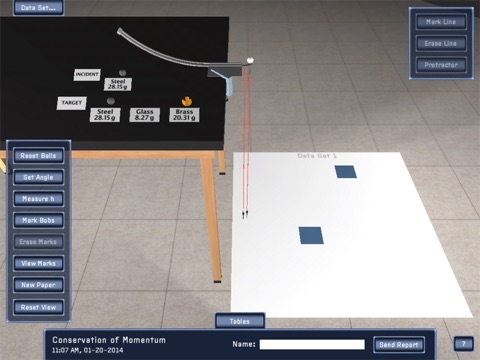
PP+ Conservation of Momentum
The Conservation of Momentum lab uses two colliding bodies to investigate elastic and inelastic collisions and compare kinetic energy. It is part of Polyhedron Physics Plus, a set of 24 iPad apps for use in the classroom. To see how they work, try the FREE PP+ Newton’s 2nd Law lab. For those who’d prefer to develop their own experiments, the PP Conservation of Momentum app features a similar apparatus without lab procedures and other supporting materials.
In addition to a 3D simulation that produces realistic data, each lab includes introductory videos, background theory, experimental procedure, analysis and reporting tools, pre-lab quiz, post-lab questions, and teacher support materials. The experimental data produced by the simulations are realistic, including random and systematic errors. These features allow students to use standard data analysis and error analysis techniques to report on their own unique data, just as if the experiment had been performed using hands-on equipment.
These labs can serve as replacements for hands-on labs, especially when equipment is not available, or as supplements to hands-on labs. They are also a suitable option for students in distance learning and home school situations. Formative and summative evaluations showed no significant difference in learning between students using the virtual labs and those using hands-on labs. Preliminary results suggest increased learning by students using the virtual labs as supplements to hands-on.
Polyhedron Physics was developed by Polyhedron Learning Media, Inc. with partial funding provided under contract numbers ED-07-CO-0040 and ED-IES-11-C-0029 from the Institute of Education Sciences in the U.S. Department of Education through the Small Business Innovation Research (SBIR) program.
In addition to a 3D simulation that produces realistic data, each lab includes introductory videos, background theory, experimental procedure, analysis and reporting tools, pre- and post-lab quizzes, and teacher support materials.
These labs can serve as replacements for hands-on labs, especially when equipment is not available, or as supplements to hands-on labs. They are also a suitable option for students in distance learning situations. Formative and summative evaluations showed no significant difference in learning between students using the virtual labs and those using hands-on labs. Preliminary results suggest increased learning by students using the virtual labs as supplements to hands-on.
HSVPL was developed by Polyhedron Learning Media, Inc. and is distributed in conjunction with Houghton Mifflin Harcourt. Funding for this project was provided under contract number ED-IES-11-C-0029 by the Institute of Education Sciences in the U.S. Department of Education through the Small Business Innovation Research (SBIR) program.



